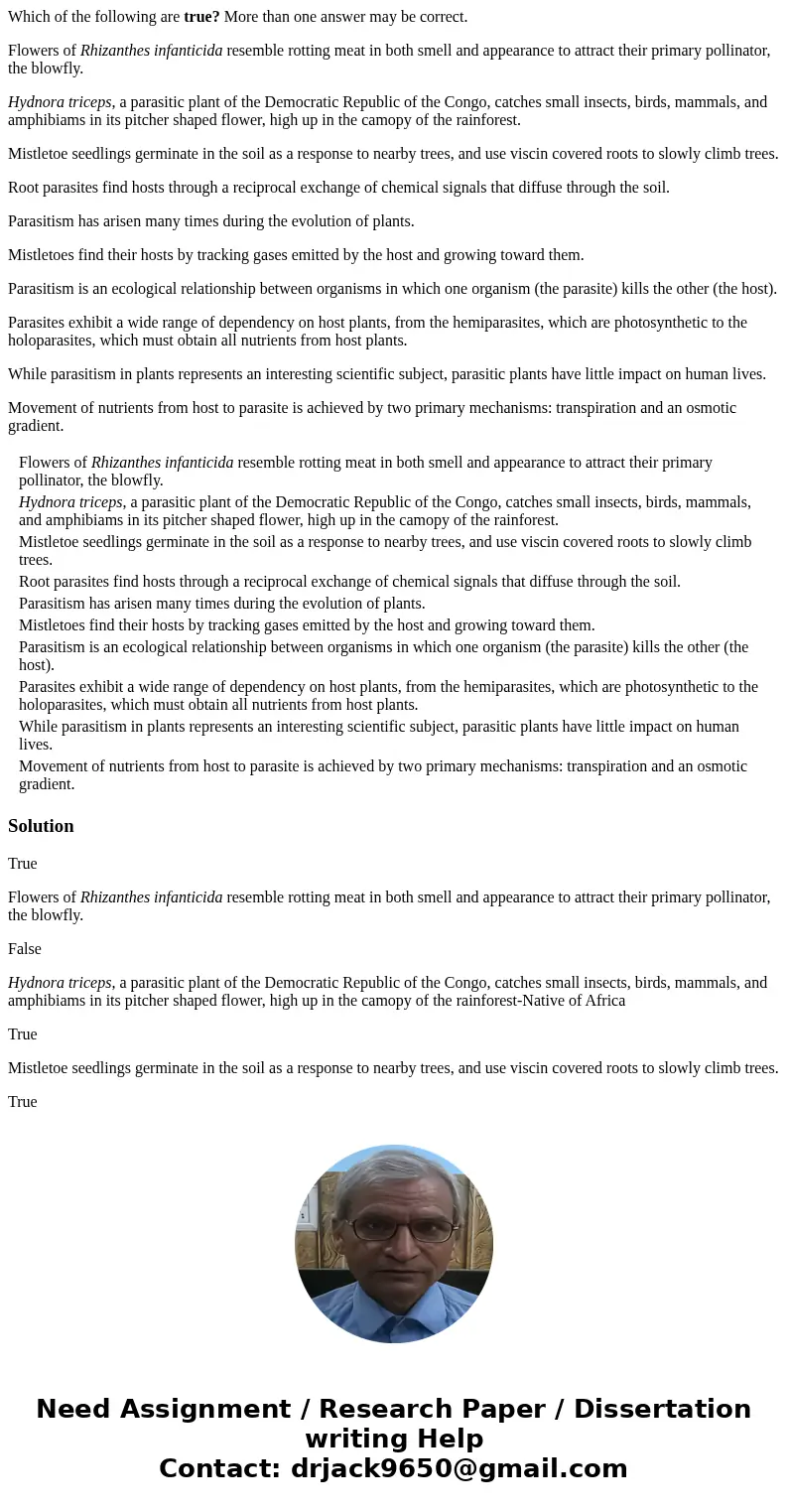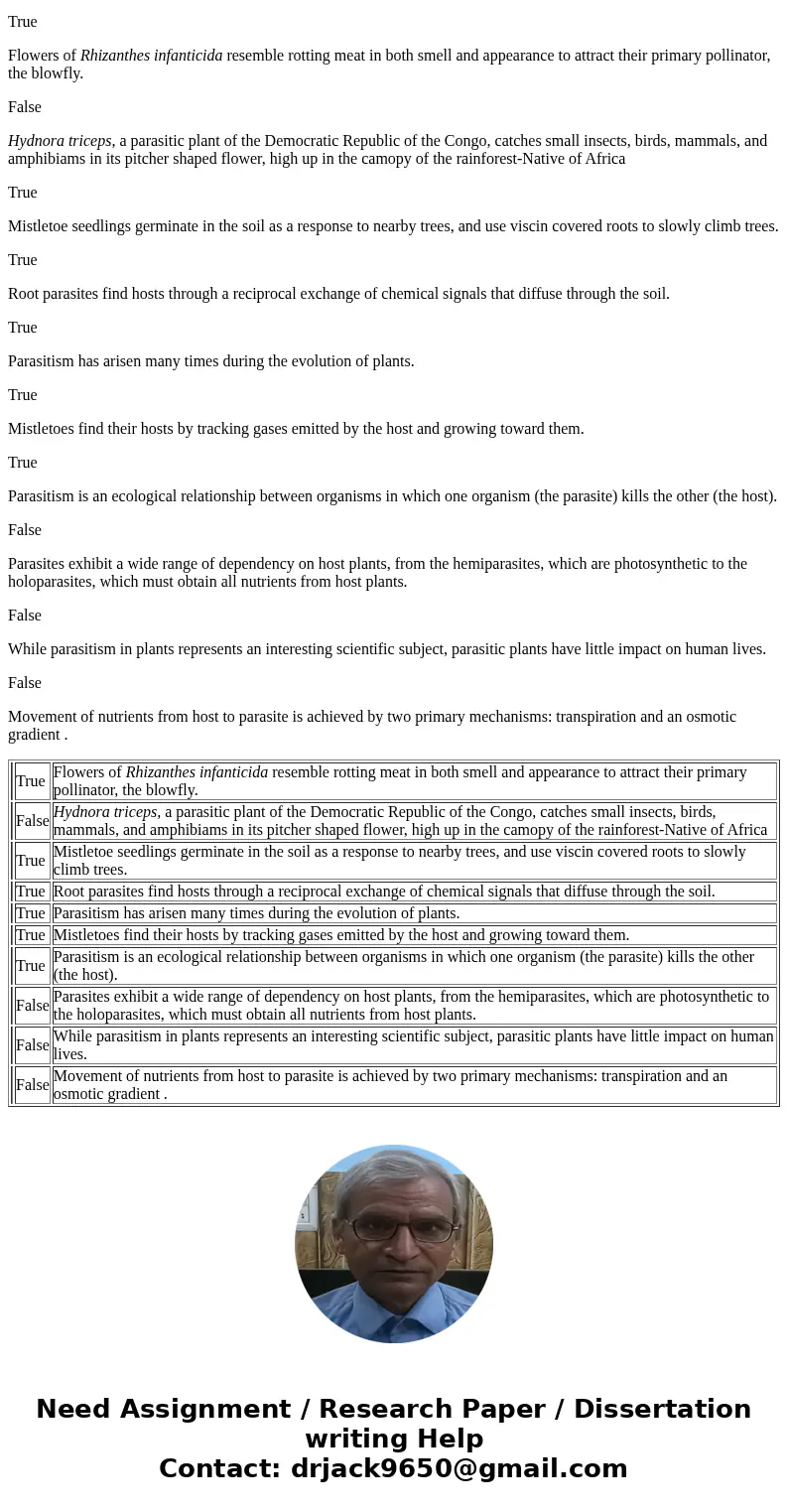Which of the following are true More than one answer may be
Which of the following are true? More than one answer may be correct.
Flowers of Rhizanthes infanticida resemble rotting meat in both smell and appearance to attract their primary pollinator, the blowfly.
Hydnora triceps, a parasitic plant of the Democratic Republic of the Congo, catches small insects, birds, mammals, and amphibiams in its pitcher shaped flower, high up in the camopy of the rainforest.
Mistletoe seedlings germinate in the soil as a response to nearby trees, and use viscin covered roots to slowly climb trees.
Root parasites find hosts through a reciprocal exchange of chemical signals that diffuse through the soil.
Parasitism has arisen many times during the evolution of plants.
Mistletoes find their hosts by tracking gases emitted by the host and growing toward them.
Parasitism is an ecological relationship between organisms in which one organism (the parasite) kills the other (the host).
Parasites exhibit a wide range of dependency on host plants, from the hemiparasites, which are photosynthetic to the holoparasites, which must obtain all nutrients from host plants.
While parasitism in plants represents an interesting scientific subject, parasitic plants have little impact on human lives.
Movement of nutrients from host to parasite is achieved by two primary mechanisms: transpiration and an osmotic gradient.
| Flowers of Rhizanthes infanticida resemble rotting meat in both smell and appearance to attract their primary pollinator, the blowfly. | ||
| Hydnora triceps, a parasitic plant of the Democratic Republic of the Congo, catches small insects, birds, mammals, and amphibiams in its pitcher shaped flower, high up in the camopy of the rainforest. | ||
| Mistletoe seedlings germinate in the soil as a response to nearby trees, and use viscin covered roots to slowly climb trees. | ||
| Root parasites find hosts through a reciprocal exchange of chemical signals that diffuse through the soil. | ||
| Parasitism has arisen many times during the evolution of plants. | ||
| Mistletoes find their hosts by tracking gases emitted by the host and growing toward them. | ||
| Parasitism is an ecological relationship between organisms in which one organism (the parasite) kills the other (the host). | ||
| Parasites exhibit a wide range of dependency on host plants, from the hemiparasites, which are photosynthetic to the holoparasites, which must obtain all nutrients from host plants. | ||
| While parasitism in plants represents an interesting scientific subject, parasitic plants have little impact on human lives. | ||
| Movement of nutrients from host to parasite is achieved by two primary mechanisms: transpiration and an osmotic gradient. |
Solution
True
Flowers of Rhizanthes infanticida resemble rotting meat in both smell and appearance to attract their primary pollinator, the blowfly.
False
Hydnora triceps, a parasitic plant of the Democratic Republic of the Congo, catches small insects, birds, mammals, and amphibiams in its pitcher shaped flower, high up in the camopy of the rainforest-Native of Africa
True
Mistletoe seedlings germinate in the soil as a response to nearby trees, and use viscin covered roots to slowly climb trees.
True
Root parasites find hosts through a reciprocal exchange of chemical signals that diffuse through the soil.
True
Parasitism has arisen many times during the evolution of plants.
True
Mistletoes find their hosts by tracking gases emitted by the host and growing toward them.
True
Parasitism is an ecological relationship between organisms in which one organism (the parasite) kills the other (the host).
False
Parasites exhibit a wide range of dependency on host plants, from the hemiparasites, which are photosynthetic to the holoparasites, which must obtain all nutrients from host plants.
False
While parasitism in plants represents an interesting scientific subject, parasitic plants have little impact on human lives.
False
Movement of nutrients from host to parasite is achieved by two primary mechanisms: transpiration and an osmotic gradient .
| True | Flowers of Rhizanthes infanticida resemble rotting meat in both smell and appearance to attract their primary pollinator, the blowfly. | |
| False | Hydnora triceps, a parasitic plant of the Democratic Republic of the Congo, catches small insects, birds, mammals, and amphibiams in its pitcher shaped flower, high up in the camopy of the rainforest-Native of Africa | |
| True | Mistletoe seedlings germinate in the soil as a response to nearby trees, and use viscin covered roots to slowly climb trees. | |
| True | Root parasites find hosts through a reciprocal exchange of chemical signals that diffuse through the soil. | |
| True | Parasitism has arisen many times during the evolution of plants. | |
| True | Mistletoes find their hosts by tracking gases emitted by the host and growing toward them. | |
| True | Parasitism is an ecological relationship between organisms in which one organism (the parasite) kills the other (the host). | |
| False | Parasites exhibit a wide range of dependency on host plants, from the hemiparasites, which are photosynthetic to the holoparasites, which must obtain all nutrients from host plants. | |
| False | While parasitism in plants represents an interesting scientific subject, parasitic plants have little impact on human lives. | |
| False | Movement of nutrients from host to parasite is achieved by two primary mechanisms: transpiration and an osmotic gradient . |


 Homework Sourse
Homework Sourse